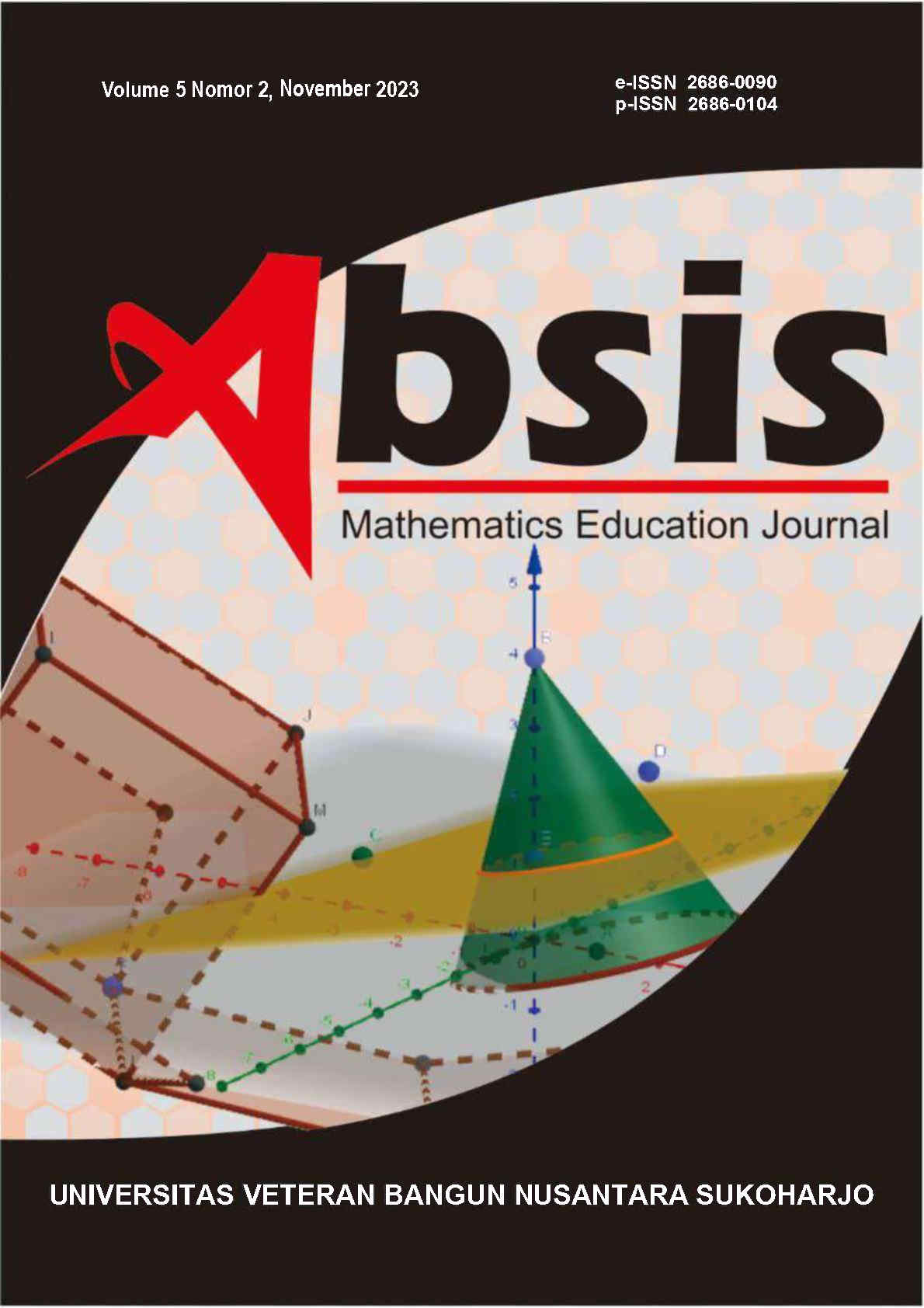Analisis Kemampuan Komunikasi Matematika dalam Materi Statistika Kelas VIII SMP
DOI:
https://doi.org/10.32585/absis.v5i2.2718Abstract
This study aims to describe the mathematical communication skills of eighth-grade students of SMP Negeri 2 Jatiroto in statistical material. This research is a qualitative research. The subjects of this study were students of class VIII E SMP Negeri 2 Jatiroto. Data collection techniques used in this study were tests and interviews. Data analysis techniques used are data reduction, data presentation, and drawing conclusions.
The results of this study, the subjects selected were 6 students with 2 subjects of high achievement, 2 subjects of moderate achievement, and 2 subjects of low achievement. With high achievement subjects meeting the 5 indicators of mathematical communication ability given, medium achievement subjects meeting 2 indicators of given mathematical communication skills, and low achievement subjects fulfilling 1 indicator of given mathematical communication skills. The conclusions of the study indicate that the mathematical communication skills of class VIII students of SMP Negeri 2 Jatiroto in statistical material are as follows: (1) students with high achievement have good mathematical communication skills, (2) students with moderate achievement have quite good mathematical communication skills, (3) students with low achievement have poor mathematical communication skills.
Downloads
References
Ansari BI. (2018). Komunikasi Matematika Strategi Berfikir dan Manajemen Belajar. yayasan pena.
Ariawan, R., & Nufus, H. (2017). 301729-Hubungan-Kemampuan-Pemecahan-Masalah-Mat-598F71E9. 1(2), 82–91.
Hendriana, Heris, dkk. (2018). Hard Skill dan Soft Skill Matematik Siswa. PT. Refika Aditama.
Hidajat, D., Wulandari, A. A., & Susilowati, D. (2018). Pengaruh Penggunaan Miniatur Mobil Terhadap Prestasi Belajar Matematika. Edudikara, ISSN: 2541-0261, 3(1), 14–22.
Hikmah, A., Roza, Y., & Maimunah, M. (2019). Analisis Kemampuan Komunikasi Matematis Siswa Smp Pada Soal Spldv. Media Pendidikan Matematika, 7(1), 29. https://doi.org/10.33394/mpm.v7i1.1428
Hodiyanto, H. (2017). Kemampuan Komunikasi Matematis Dalam Pembelajaran Matematika. AdMathEdu : Jurnal Ilmiah Pendidikan Matematika, Ilmu Matematika Dan Matematika Terapan, 7(1), 9. https://doi.org/10.12928/admathedu.v7i1.7397
Prayitno, S., Suwarsono, S., & Siswono, T. Y. E. (2013). Identifikasi Indikator Komunikasi Matematis Siswa SMP dalam Menyelesaikan Soal Matematika Berjenjang pada Tiap-tiap Jenjangnya. Konferensi Nasional Pendidikan Matematika V.
Purnama, I. L., & Aldila, E. (2016). Kemampuan Komunikasi Matematis Siswa Ditinjau Melalui Model Pembelajaran Kooperatif Tipe Complete Sentence Dan Team Quiz. Jurnal Pendidikan Matematika, 10(1), 27–42. https://doi.org/10.22342/jpm.10.1.3267.26-41
Puspaningtyas, N., Prasetyo, K. H., & Farahsanti, I. (2021). Penerapan Model Pembelajaran Kooperatif Snowball Throwing Dengan Discovery Learning Untuk Meningkatkan Keaktifan Dan Prestasi. Absis: Mathematics Education Journal, 2(1), 11. https://doi.org/10.32585/absis.v2i1.705
Saepudin, F., Prillangga, P., & Zanthy, L. S. (2019). Analisis Kemampuan Komunikasi Matematis Siswa SMP Kelas VIII. Journal On Education, 1(4).
Salam, R. (2017). Efektivitas penggunaan model pembelajaran kooperatif tipe Think Pair Share ( TPS ) untuk meningkatkan kepercayaan diri dan komunikasi. Penelitian Pendidikan INSANI, 20(2).
Sriwahyuni, T. (2018). Analisis kemampuan komunikasi matematis siswa smp pada materi statistika. Jurnal Kajian Pembelajaran Matematika, 1(6), 1095–1104.
Sulistiani, I., Santoso, & Ulya, H. (2021). Kemampuan Komunikasi Matematis Siswa Sekolah Dasar melalui Pembelajaran Daring. Edukatif: Jurnal Ilmu Pendidikan, 3(4).
Wijaya, A. (2012). pendekatan matematika realistik: suatu alternatif pendekatan matematika. graha ilmu.
Downloads
Published
How to Cite
Issue
Section
License
Copyright (c) 2024 Eli Setianingsih, Herry Agus Susanto, Isna Farahsanti

This work is licensed under a Creative Commons Attribution-ShareAlike 4.0 International License.
Authors who publish with the Absis: Mathematics Education Journal agree to the following terms:
- Authors retain copyright and grant the journal the right of first publication with the work simultaneously licensed under a Creative Commons Attribution License (CC BY-SA 4.0) that allows others to share the work with an acknowledgment of the work's authorship and initial publication in this journal.
- Authors are able to enter into separate, additional contractual arrangements for the non-exclusive distribution of the journal's published version of the work (e.g., post it to an institutional repository or publish it in a book), with an acknowledgment of its initial publication in this journal.
- Authors are permitted and encouraged to post their work online (e.g., in institutional repositories or on their website) prior to and during the submission process, as it can lead to productive exchanges, as well as earlier and greater citation of published work.







